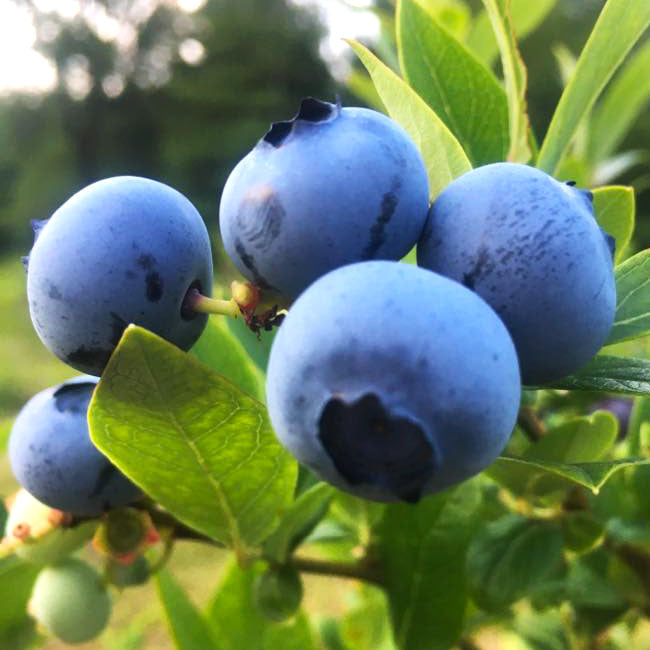Blueberries are fruiting shrubs that normally grow quite well in the climatic conditions of Quebec. At Ferme Giroflée, we offer several varieties of plants that you can purchase to enjoy the freshness of these delicious blue berries at different times of summer.
To ensure the full potential of flavors while giving large fruits bursting with polyphenols and antioxidants, it is important to plan the planting according to the needs of the plants. This is why we offer you some tips according to the aspects to consider when planting your plants:
Sunshine duration and wind protection
Preferably in full sun, while supporting a little shade, it is important to consider a location that will offer at least 5 to 8 hours of sunshine per day. You must also make sure that your blueberries will be sheltered from strong winter winds in order to protect the fruit buds.
Spacing between the plants
A spacing of 1 to 1.5m should be provided between blueberry plants. Even if they are very small when purchased, once mature, they will become shrubs that can reach a height of about 1.5m with a diameter of 1.5m.
Choice of soil and good neighborhood
Blueberries will grow well in well-drained soil. Very clayey sites or sites with poor drainage are therefore to be avoided, but if this is the case, techniques will be advised on the farm.
It is also not recommended to place your blueberry plants near cedars which can be bad neighbours. It is recommended to plant them more than 3m apart. If you want to cover the soil of your blueberries with wood chips (2 inches), it is also preferable to choose species other than cedar, which is considered toxic for blueberries. You should therefore use shavings from pine or hardwood trees instead.
Irrigation
Moistening the peat moss well before planting and then watering the soil sufficiently after planting during the first 3 to 4 weeks is important to allow good root establishment. Thereafter, be sure to water the shrubs regularly as needed for the season. This will allow the optimal growth of your plants.
Fertilisation
Fertilization is also essential for plant growth. Minerals are actually food for your plants. Annual fertilization with granulated, dried manure is safe for blueberry plants. We therefore recommend applying it between May 1 and 15 and the dose will vary according to the age, biomass* and stage of the plant.
Maintaining an acidic pH around blueberries is also an important element to consider. They are fond of acidity. It is therefore advisable to use peat moss when planting and to apply sulfur granules to the soil annually to maintain the medium near the roots at the desired acidity.
Here are the planting steps:
1 - Dig a hole in the ground that will be 3 to 5 times larger than the size of the pot in which the plant is purchased. For small plants that will be put in a rather clayey ground, it will be necessary to provide a slightly larger hole and more peat moss.
2 - At the bottom of the hole, sprinkle a little organic quality fertilizer (250 g/plant) and sulfur granules (30-40 g/plant).
3 - In a container (like a wheelbarrow), moisten the peat moss with a good amount of water and stir until it is well waterlogged. Check by pressing with your hand if the foam has absorbed the water well.
4 - Place moistened peat moss at the bottom of the hole, install the plant gently on it by spreading its roots, close the hole with soil and apply good pressure all around the blueberry plant.
5 - Sprinkle the surface of the soil with a little organic fertilizer (250 g/plant) and sulfur granules (30-40 g/plant), about 30 cm (1 foot) in radius around the trunk of the blueberry. It is advisable to do this fertilization technique every spring.
6 - To limit the appearance of weeds, place between 3 and 5 cm (1 to 2 inches) of wood chips around your plants.
Patience is the mother of all virtues! But we still thought about keeping extra large blueberry plants in our inventory, which already produce 3 to 4 pounds of fruit annually. While small plants will take more than a year to reach 1-2 pounds of berries for your consumption.
Winter preparation
Just before the cold winter weather arrives, we recommend adding sulfur to the base of your blueberry plants and then placing a cover of wood shavings or dead leaves. In addition to creating a little heat, the decomposition process will release nutrients.
One of the most important recommendations we can give you is NOT TO PRUNE YOUR PLANTS IN THE FALL. Unhealed cuts will cause cold to enter the sap and could kill your blueberry bushes. It is therefore always recommended to prune in spring.
Make your online shopping now!


